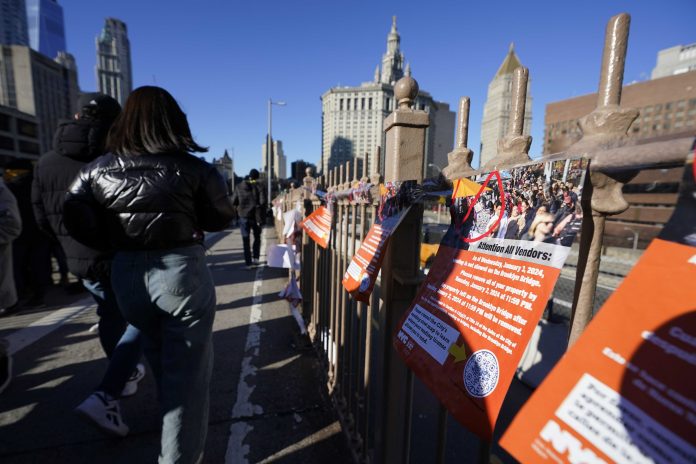
By JAKE OFFENHARTZ
Associated Press
NEW YORK (AP) — Scores of sellers that once peddled cheap souvenirs to tourists atop the Brooklyn Bridge were evicted Wednesday under a new city rule that prohibits vending on the famed crossing.
The ban is aimed at easing congestion on the bridge’s heavily-trafficked pedestrian walkway, which has seen a spike in both visitors and tabletop businesses offering items like New York-branded hats and keychains.
As crowds flocked to the bridge over the holiday season, the situation turned dangerous, according to New York City Mayor Eric Adams. He pointed to videos that showed pedestrians leaping from the pedestrian promenade onto a bike lane several feet below in order to bypass a human traffic jam.
“It’s not only a sanitary issue, it’s a public safety issue,” Adams said. “People would’ve trampled over each other. We need order in this city. That is one of our major landmarks.”
Police officers were stationed in pairs Wednesday along the mile-long span, as a group of disgruntled vendors stood at the Manhattan entrance to the bridge, glumly facing their former marketplace. Along the bridge’s trusses, city employees hung signs reading: “No vending allowed.”
Kendall Otway, a 67-year-old vendor, said he began selling merchandise on the bridge last year, working with a growing group of asylum seekers who have recently arrived in New York City from Ecuador and Senegal.
“Wasn’t it the mayor who said they should come here and work?” Otway said, adding that the vendors had become “a staple of New York City now.”
The new rules prevent any “peddler, vendor, hawker, or huckster” from selling merchandise or providing a service on any of the city’s bridges or elevated walkways — though none have close to as many vendors as the 140-year-old Brooklyn Bridge.
In recent months, the number of tables on the East River crossing offering phone cases and knock-off Yankees caps had multiplied. Other entrepreneurs had set up rotating selfie platforms that allow tourists to take panoramic videos of the New York Harbor.”The tourists liked the vendors, they always seemed to have business,” said Robert Fernandez, a Brooklyn resident who frequently walks the bridge. Still, he said it was “much easier” to cross the bridge on Wednesday without the “choke points” caused by the vendors.
Some sellers said they planned to wait a few weeks for the fuss to die down before trying to come back. Others set up tables near City Hall, across from the bridge, hoping to unload their remaining wares away from the high-profile enforcement zone.
MD Rahman, who has sold hot dogs and pretzels out of a cart on the bridge for 15 years, said he had initially planned to defy the city’s rules. But when he saw officers fanned out across the bridge, he decided not to take the risk.
Rahman said he understands the need to crack down on illicit vendors. But he criticized the ban as overly broad, since it also applies to veteran sellers, like himself, who hold mobile vending licenses.
“To punish everyone, it’s crazy. I don’t know what is going to happen to my family now,” he said.
On Wednesday afternoon, despite the absence of vendors, a group of pedestrians found themselves stuck in foot-traffic beneath the bridge’s stone arches. The hold-up soon became clear: a line of tourists had stopped to take photographs of the “No vending” signs.



















